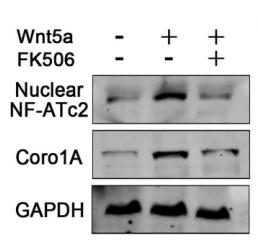CORO1A Antibody - #DF3148
| Product: | CORO1A Antibody |
| Catalog: | DF3148 |
| Description: | Rabbit polyclonal antibody to CORO1A |
| Application: | WB IHC IF/ICC |
| Cited expt.: | WB, IHC |
| Reactivity: | Human, Mouse, Rat |
| Prediction: | Pig, Zebrafish, Bovine, Horse, Sheep, Rabbit, Dog |
| Mol.Wt.: | 52 KD; 51kD(Calculated). |
| Uniprot: | P31146 |
| RRID: | AB_2835525 |
Related Downloads
Protocols
Product Info
*The optimal dilutions should be determined by the end user. For optimal experimental results, antibody reuse is not recommended.
*Tips:
WB: For western blot detection of denatured protein samples. IHC: For immunohistochemical detection of paraffin sections (IHC-p) or frozen sections (IHC-f) of tissue samples. IF/ICC: For immunofluorescence detection of cell samples. ELISA(peptide): For ELISA detection of antigenic peptide.
Cite Format: Affinity Biosciences Cat# DF3148, RRID:AB_2835525.
Fold/Unfold
Actin binding protein; CLABP; Clipin A; Clipin-A; CLIPINA; COR1A_HUMAN; CORO1A; Coronin 1; Coronin actin binding protein 1A; Coronin like protein A; Coronin like protein p57; Coronin-1A; Coronin-like protein A; Coronin-like protein p57; FLJ41407; HCORO1; MGC117380; OTTHUMP00000163017; p57; TACO; Tryptophan aspartate containing coat protein; Tryptophan aspartate-containing coat protein;
Immunogens
A synthesized peptide derived from human CORO1A, corresponding to a region within the internal amino acids.
Expressed in brain, thymus, spleen, bone marrow and lymph node. Low in lung and gut.
- P31146 COR1A_HUMAN:
- Protein BLAST With
- NCBI/
- ExPASy/
- Uniprot
MSRQVVRSSKFRHVFGQPAKADQCYEDVRVSQTTWDSGFCAVNPKFVALICEASGGGAFLVLPLGKTGRVDKNAPTVCGHTAPVLDIAWCPHNDNVIASGSEDCTVMVWEIPDGGLMLPLREPVVTLEGHTKRVGIVAWHTTAQNVLLSAGCDNVIMVWDVGTGAAMLTLGPEVHPDTIYSVDWSRDGGLICTSCRDKRVRIIEPRKGTVVAEKDRPHEGTRPVRAVFVSEGKILTTGFSRMSERQVALWDTKHLEEPLSLQELDTSSGVLLPFFDPDTNIVYLCGKGDSSIRYFEITSEAPFLHYLSMFSSKESQRGMGYMPKRGLEVNKCEIARFYKLHERRCEPIAMTVPRKSDLFQEDLYPPTAGPDPALTAEEWLGGRDAGPLLISLKDGYVPPKSRELRVNRGLDTGRRRAAPEASGTPSSDAVSRLEEEMRKLQATVQELQKRLDRLEETVQAK
Predictions
Score>80(red) has high confidence and is suggested to be used for WB detection. *The prediction model is mainly based on the alignment of immunogen sequences, the results are for reference only, not as the basis of quality assurance.
High(score>80) Medium(80>score>50) Low(score<50) No confidence
Research Backgrounds
May be a crucial component of the cytoskeleton of highly motile cells, functioning both in the invagination of large pieces of plasma membrane, as well as in forming protrusions of the plasma membrane involved in cell locomotion. In mycobacteria-infected cells, its retention on the phagosomal membrane prevents fusion between phagosomes and lysosomes.
phosphorylation at Thr-412 by PKC strongly down-regulates the association with actin.
Polyubiquitinated by RNF128 with 'Lys-48'-linked chains, leading to proteasomal degradation.
Cytoplasm>Cytoskeleton. Cytoplasm>Cell cortex. Cytoplasmic vesicle>Phagosome membrane.
Note: In non-infected macrophages, associated with the cortical microtubule network. In mycobacteria-infected macrophages, becomes progressively relocalized and retained around the mycobacterial phagosomes. Retention on the phagosomal membrane is strictly dependent on mycobacterial viability and not due to impaired acidification (By similarity).
Expressed in brain, thymus, spleen, bone marrow and lymph node. Low in lung and gut.
Belongs to the WD repeat coronin family.
Research Fields
· Cellular Processes > Transport and catabolism > Phagosome. (View pathway)
· Human Diseases > Infectious diseases: Bacterial > Tuberculosis.
References
Application: WB Species: human Sample: AM-1 cells
Application: IHC Species: human Sample: oral mucosa tissues and ameloblastoma tissues
Restrictive clause
Affinity Biosciences tests all products strictly. Citations are provided as a resource for additional applications that have not been validated by Affinity Biosciences. Please choose the appropriate format for each application and consult Materials and Methods sections for additional details about the use of any product in these publications.
For Research Use Only.
Not for use in diagnostic or therapeutic procedures. Not for resale. Not for distribution without written consent. Affinity Biosciences will not be held responsible for patent infringement or other violations that may occur with the use of our products. Affinity Biosciences, Affinity Biosciences Logo and all other trademarks are the property of Affinity Biosciences LTD.

